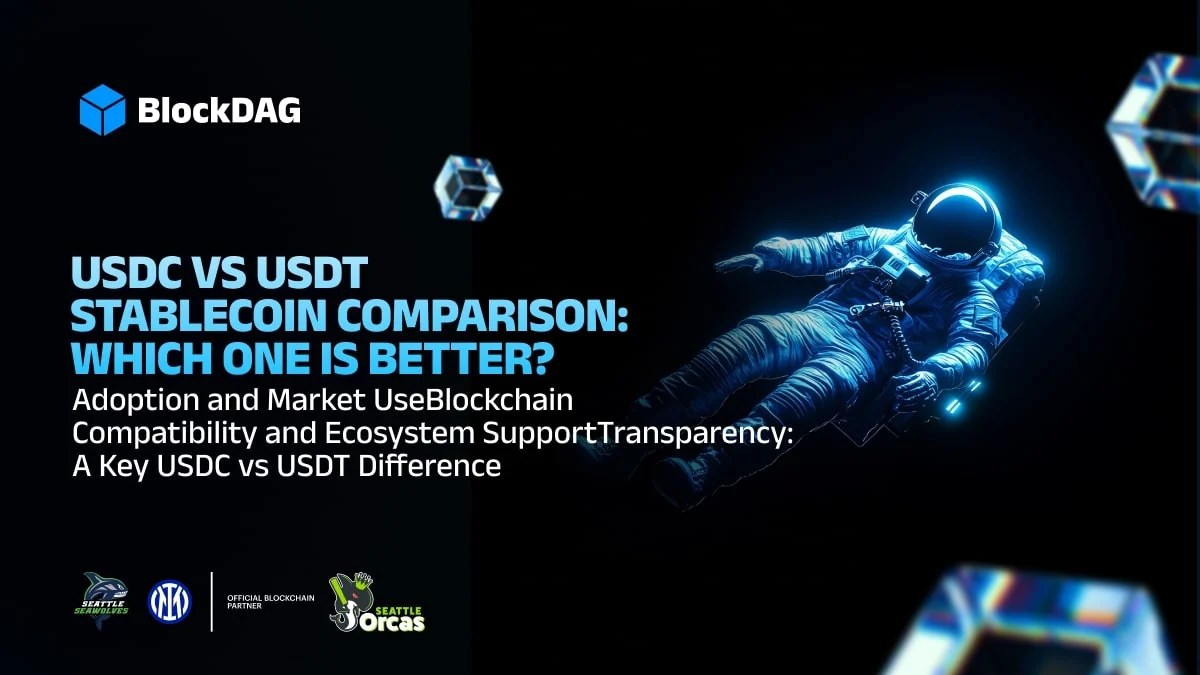The Creation of USDC and USDT
Adoption and Market Use
Blockchain Compatibility and Ecosystem Support
Transparency: A Key USDC vs USDT Difference
Regulatory Compliance: The Game Changer
Transaction Fees and Speed
Use Cases: Which Is Better for You?
Security and Trust
So, Who Wins the Stablecoin Showdown?
Looking Toward the Future with BlockDAG
Stablecoins have become essential in the modern digital economy, offering the convenience of cryptocurrencies with the reliability of fiat currencies. Among the top contenders, USDC and USDT dominate the stablecoin market. But when it comes to USDC vs USDT, which is better? This guide presents a full USDC vs USDT comparison, covering their differences in transparency, use cases, regulation, and more to help you make an informed decision.
The Creation of USDC and USDT
It all started with its launch. Let us walk you through the beginning. USDT, or Tether, was launched in 2014 and is currently the most widely used stablecoin across the world. It is operated by Tether Limited and it became the traders' favourite for a more dollar pegged asset stablecoin shortly after its launch.
USDC was launched in 2018, though, by the Centre Consortium, a collaborative effort between financial technology firm Circle and cryptocurrency exchange Coinbase. Though newer to the market, USDC is rapidly growing with its focus on transparency and compliance.
In terms of origin and backing institutions, USDC earns more trust among institutions, while USDT enjoys a longer history and greater user adoption.
Adoption and Market Use
When it comes to real world use adoption, USDT still holds the crown. It has the highest market capitalization among all stablecoins and is frequently used in high volume trading on major centralized exchanges.
Though USDC is slightly smaller in market cap, it is subsequently fast catching up and has carved out a solid reputation within decentralized finance (DeFi) and institutional applications. Major platforms and protocols often integrate USDC due to its compliance with U.S regulations.
In the USDC vs USDT comparison, USDT is more prevalent in global trading, while USDC is the stablecoin of choice in regulated financial environments.
Blockchain Compatibility and Ecosystem Support

Both USDT and USDC are available across multiple blockchain networks. USDT is widely used on Ethereum, Tron, Binance Smart Chain and Solana. Its TRC-20 version on Tron is especially popular due to low transaction fees and fast processing.
USDC, is also available on Ethereum and has expanded to popular networks like polygon, Arbitrum. Avalanche, and Base. Its adoption across layer 2 solutions makes it a strong player in the Defi world.
Considering the availability, USDT might offer slightly broader support, but USDC is becoming a favorite in the initial and more efficient blockchain ecosystem.
Transparency: A Key USDC vs USDT Difference
One major difference between USDC and USDT lies in transparency. Over the past couple of years, Tether has faced intense scrutiny regarding whether or not each USDT is truly backed by a U.S. dollar or an equivalent asset. While Tether now provides public attestation, the breakdown of reserves has often raised concerns, including holdings in commercial paper and other non cash assets. ç
Conversely, USDC takes transparency seriously. Circle publishers briefed monthly reports, audited by the third party firms. These reports confirm that each USDC is fully backed by cash or U.S Treasuries, offering peace of mind to users and regulators alike.
If transparency and regulatory reporting are important to you, then USDC has a clear edge in this stablecoins comparison.
Regulatory Compliance: The Game Changer
Regulatory scrutiny is increasing across the entire crypto sector. Tether has experienced probes and fines in the past related to its reporting of reserves. While it is still open and growing, investors remain wary over the lack of extensive audits.
USDC, meanwhile, is built with compliance in mind. Circle has branded USDC as a fully regulated digital dollar, working closely with U.S. lawmakers and regulators. Institutional investors and firms looking for a compliant and secure stablecoin are naturally drawn to USDC.
This is a critical area in the USDC vs USDT comparison, especially as governments and financial institutions demand more accountability in digital finance.
Transaction Fees and Speed
The fees and speed depends entirely on the network being used. USDT on the Tron network (TRC-20) is widely known for being fast and cheap making it an excellent option for cross border payments and exchange transfers.
USDC, while initially tied to Ethereum (which can be expensive during high traffic), has evolved. It's now available on cost-efficient chains like Polygon, Arbitrum, and Base, enabling fast and inexpensive transactions.
In practice, both stablecoins are becoming more efficient, but if you’re using Ethereum, USDT could be expensive, while USDC on layer-2 chains offers better alternatives.
Use Cases: Which Is Better for You?
If you're an expert trader or someone frequently moving funds between exchanges, USDT offers unmatched liquidity. Its dominance in offshore markets and trading pairs makes it the preferred choice for arbitrage and quick swaps.
But if you're an investor who's engaging with DeFi protocols, yield farming, or seeking exposure to an institutional and transparent stablecoin, USDC is generally the better choice.
Therefore, when it comes to USDC vs USDT, which is most suitable to your needs, it is a question of whether you prioritize trading convenience or regulatory compliance and transparency.
Security and Trust
Security in the crypto world is not just about smart contracts or cold wallets, it also depends whether the stablecoin you hold is truly backed by assets. Tether has struggled with this narrative due to its opaque history.
USDC has gained investor trust through consistent audits, transparency in reserves, and adherence to financial reporting standards. Users feel more secure knowing they can verify USDC’s backing.
So, in the question of USDC vs USDT, which is better for trust, USDC typically leads, especially for those cautious of potential risks.
So, Who Wins the Stablecoin Showdown?
When weighing all the USDC vs USDT differences, it’s clear that both coins have unique strengths:
- Go with USDC if regulatory compliance, transparency, and safe DeFi or institutional involvement are important to you.
- There is no one-size-fits-all victor in USDC vs USDT, as your use case pretty much dictates which stablecoin is superior for you. Traders might prefer USDT, but long-term holders and institutions prefer USDC.
Looking Toward the Future with BlockDAG
As you examine stablecoins like USDC and USDT, look to the future of blockchain infrastructure itself. One emerging technology that is changing how we think about scalability and speed is BlockDAG technology.
In contrast with the linear blockchains of the past, BlockDAG (Directed Acyclic Graph) allows for multiple blocks or transactions to be verified simultaneously. This means faster speeds, higher throughput, and reduced fees, perfect for stablecoin systems and everyday use.
BlockDAG is gaining attention as a best crypto ICO. If you’re excited about the evolution of digital finance beyond the current USDC vs USDT debate, then BlockDAG is a powerful technology worth watching.
